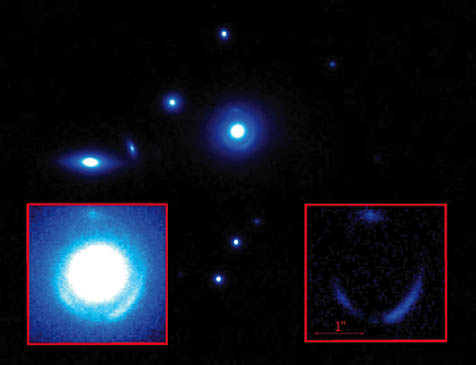UCSB Scientists Observe Galaxy 100 Times Lighter than Milky Way
A Galaxy Far, Far Away

Researchers at UC Santa Barbara continue to make groundbreaking discoveries, this time in the realm of astrophysics. Phil Marshall, a postdoctoral fellow at UCSB, and Tommaso Treu, assistant professor of physics, participated on an international team of scientists that conducted a study of a galaxy located halfway across the universe. The galaxy is the smallest and lightest known to exist at that distance from our own Milky Way galaxy.
Using images from NASA’s Hubble telescope and the ground-based optics at the W.M. Keck Observatory in Hawaii, scientists were able to create an image that showed a galaxy that they found to be 100 times lighter in mass than the Milky Way. What appeared to be a ring of light around a closer, denser galaxy turned out to be refracted light waves emitted from the small, distant galaxy.
A concept known as “gravitational lensing” accounts for the appearance of the circular light, which is known as an “Einstein ring.” According to Treu, gravity from a large object in space-such as a galaxy-serves the same function as glass in a lens, by refracting light waves. The resulting ring of light is comparable to the effect produced when viewing a lit candle through the bottom of a wine glass. In that case, viewing the flame through the bottom of the glass shows a ring of light-as the stem obstructs direct view-but the glass refracts the light into a bright ring.
Treu continued that a galaxy, by definition, is a collection of stars, gas, and dark matter (an unknown substance that has mass and does not emit or reflect enough light to detect directly from Earth). The material constituting the galaxy has gravitational force, which holds it together and affects light waves in such a way as to produce Einstein rings. Furthermore, by focusing the light rays, this gravitational lensing effect increases the brightness of the galaxy by more than ten times.
“Even though this galaxy is more than six-billion light years away, the reconstructed image is as sharp as the ordinary ground-based images of the nearest structure of galaxies, the Virgo cluster, which is 100 times closer to us,” said Marshall. The Einstein ring is seen because a larger galaxy lies between Earth and this “new” galaxy, creating the bull’s eye pattern. In unaligned examples, a less concentrated arc or multiple images would be formed.
In addition to creating a viewable image of the galaxy, scientists were also able to calculate the mass of the galaxy. “To determine the mass, we looked at the different light wavelengths, or colors” said Treu. Previous research indicated which wavelengths in the visible light spectrum are associated with stars of certain masses, so it was possible for the research team to infer a total mass for the newly discovered galaxy using a spectral analysis of the telescope images.
To compensate for error-especially from the blurring caused by Earth’s atmosphere-researchers used a slew of complicated imaging techniques, including “laser guide star adaptive optics.” Adaptive optics use bright stars in the field of view to measure and correct for atmospheric blurring. Because of the need for a bright star in the field of view, this technique is limited to a small fraction of the night sky.
Treu explained that Marshall did most of the work on the study, as it is his area of expertise, and that they have been working on it for about a year. “We hope to do this for hundreds of galaxies now that we know how to do it,” he said of future research plans.
Marshall’s research is funded by the TABASGO Foundation through UCSB, and Treu’s research is supported by NASA, the National Science Foundation, and the Sloan Foundation.
For more information, including a link to the related article in the Astrophysical Journal, visit tartufo.physics.



